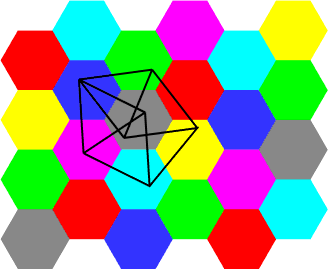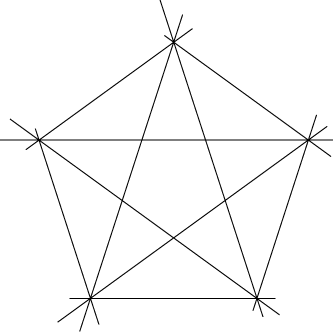
Coloring
- Algorithms for
coloring quadtrees.
- Aperiodic
colored tilings, F. Gähler.
Also
available in postscript.
- The chromatic number of the plane.
Gordon Royle and Ilan Vardi summarize what's known about
the famous open problem of how many colors are needed to color
the plane so that no two points at a unit distance apart get the same color.
See also
another article from Dave Rusin's known math pages.
- Coloring line arrangements. The graphs
formed by overlaying a collection of lines require three, four, or five colors,
depending on whether one allows three or more lines to meet at a point,
and whether the lines are considered to wrap around through infinity.
Stan Wagon
asks similar questions for unit circle arrangements.
- The
Four Color Theorem.
A new proof by Robertson, Sanders, Seymour, and Thomas.
- Geometric graph coloring problems
from "Graph Coloring Problems" by Jensen and Toft.
- Infect.
Eric Weeks generates interesting colorings of aperiodic tilings.
- Plane
color. How big can the difference between the numbers of black and
white regions in a two-colored line arrangement?
From Stan Wagon's
PotW archive.
- Puzzles
by Eric Harshbarger, mostly involving colors of and mazes on
polyhedra and polyominoes.
- Rec.puzzles archive: coloring problems.
- Solution
to problem 10769. Apparently problems of coloring the points of a
sphere so that orthogonal points have different colors (or so that each
set of coordinate basis vectors has multiple colors) has some relevance
to quantum mechanics; see also papers
quant-ph/9905080 and
quant-ph/9911040
(on coloring just the rational points on a sphere), as well as this
four-dimensional construction
of an odd number of basis sets in which each vector appears an even
number of times, showing that one can't color the points on a
four-sphere so that each basis set has exactly one black point.
- Three-color the Penrose tiling?
Mark Bickford asks if this tiling is always three-colorable.
Ivars
Peterson reports on a new proof by Tom Sibley and Stan Wagon
that the rhomb version of the tiling is 3-colorable;
A proof of 3-colorability for kites and darts
was recently published by Robert Babilon
[Discrete Mathematics 235(1-3):137-143, May 2001].
This is closely related to my page on line
arrangement coloring, since every Penrose tiling is dual to
a "multigrid", which is just an arrangement of lines in parallel families.
But my page only deals with finite arrangements, while Penrose tilings are
infinite.
- Three
nice pentomino coloring problems, Owen Muniz.
From the Geometry Junkyard,
computational
and recreational geometry pointers.
Send email if you
know of an appropriate page not listed here.
David Eppstein,
Theory Group,
ICS,
UC Irvine.
Semi-automatically
filtered
from a common source file.

